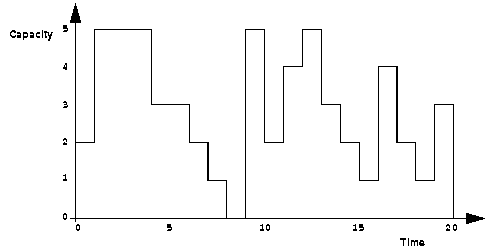Describing the Problem
 PREVIOUS
NEXT
PREVIOUS
NEXT
| IBM ILOG Scheduler User's Manual > Integrated Applications > Representing Time-Varying Resource Capacity > Describing the Problem |
Describing the Problem |
INDEX
 PREVIOUS
NEXT
PREVIOUS
NEXT
|
The problem consists of 10 activities to perform over a period of 20 days. For each activity, the following table specifies the duration of the activity and the number of people it requires.
Activity |
Duration |
Required Capacity |
A0 |
2 |
1 |
A1 |
4 |
1 |
A2 |
5 |
1 |
A3 |
6 |
1 |
A4 |
8 |
1 |
A5 |
2 |
2 |
A6 |
1 |
2 |
A7 |
3 |
1 |
A8 |
4 |
2 |
A9 |
6 |
1 |
The corresponding data are represented in the arrays Durations and RequiredCapacities. In addition, the array AvailableCapacities defines the number of people available each day, that is, from day 0 to day 19.
Figure 35.1 displays a graph of the evolution of the resource capacity over time.

Only the main function refers to the global variables just defined. When we pass the value of a global variable as an argument to another function, we derive the name of the argument from the global variable, but do not capitalize the first character of the argument name.
| © Copyright IBM Corp. 1987, 2009. Legal terms. | PREVIOUS NEXT |